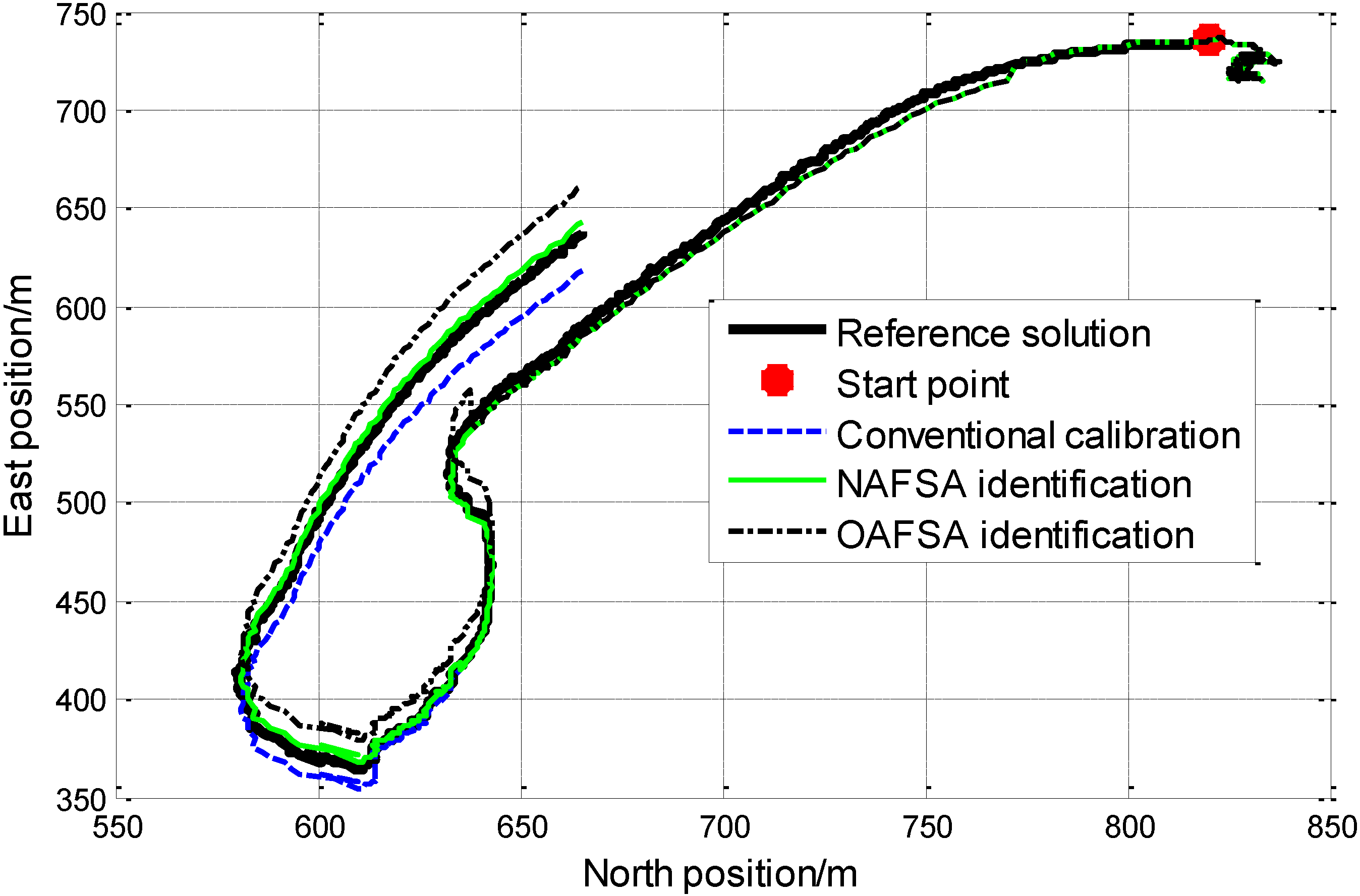A Novel Artificial Fish Swarm Algorithm for Recalibration of Fiber Optic Gyroscope Error Parameters
Abstract
:1. Introduction
2. Artificial Fish Swarm Algorithm
2.1. SAFSA and Its Demerits on FOG Error Coefficients Recalibration
2.2. OAFSA and Its Shortcomings on FOG Error Coefficients Recalibration
2.3. NAFSA and Its Advantages for FOG Error Parameters Recalibration
2.3.1. Parameters of NAFSA
2.3.2. Behaviors of NAFSA
Individual Behavior
Group Behavior
2.3.3. Advantages of NAFSA for FOG Error Parameters Recalibration
3. FOG Error Coefficients Recalibration by NAFSA
3.1. FOG Static Error Model
3.2. Derivation of the Optimization Indicator Function
3.3. MCS-NAFSA Implementation Procedures
3.3.1. FOG Error Coefficients Clustering
3.3.2. MCS-NAFSA FOG Procedures
| Algorithm: FOG NAFSA. |
Begin
for each AF i do
initialize AFs parameters, category two and category three FOG error parameters
end
bulletin = arg min f(xi) repeat
for each AF i do
Perform Individual behavior
end
for each AF i do
Perform Group behavior
end
Update Visual by Equation (5)
for each AF i do
initialize AFs and category three FOG error parameters, optimized category one FOG error parameters
end
bulletin = arg min f(xi) repeat
for each AF i do
Perform Individual behavior
end
for each AF i do
Perform Group behavior
end
Update Visual by Equation (5)
for each AF i do
initialize AFs parameters, optimized category one and category two FOG error parameters
end
bulletin = arg min f(xi) repeat
for each AF i do
Perform Individual behavior
end
for each AF i do
Perform Group behavior
end
Update Visual by Equation (5)
Until terminate condition meet
End |
4. Simulation and Discussion
4.1. Simulation Parameters Preset
| FOG Parameters Types | NAFSA AFs Parameters | ||||
|---|---|---|---|---|---|
| Visual | AFs Numbers | Iteration Times | CFmin | CFmax | |
| Kgi | (5.0000, 2.0000, 0.1000) | 50 | 60 | 0.000001 | 0.999999 |
| ωio | (0.0050, 0.0020, 0.0001) | 50 | 60 | 0.000001 | 0.999999 |
| Egij | (0.0005, 0.0002, 0.00001, 0.000005, 0.000002, 0.000001) | 50 | 60 | 0.000001 | 0.999999 |
| Parameters Types | Preset Parameters |
|---|---|
4.2. Simulation Results and Discussion
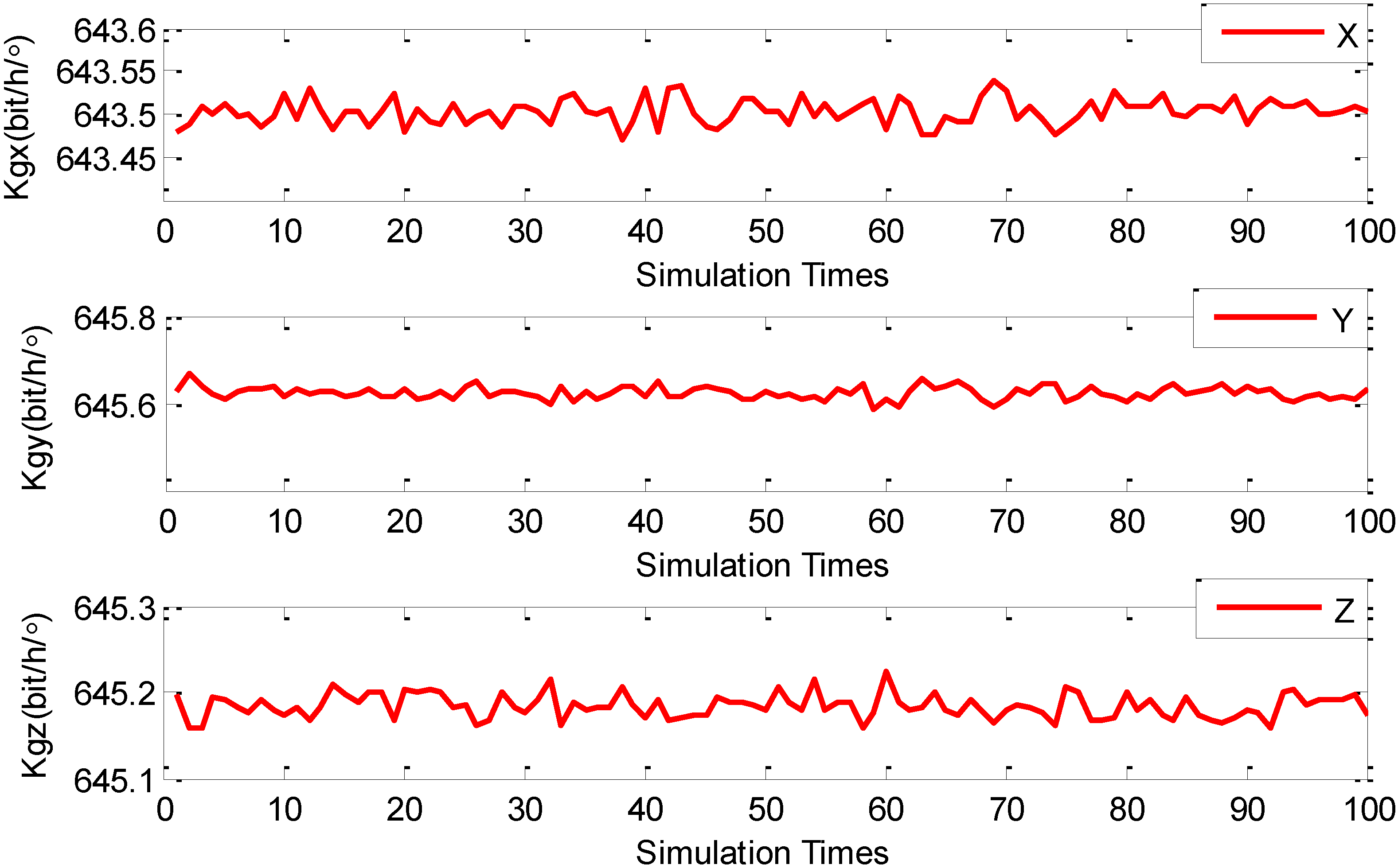
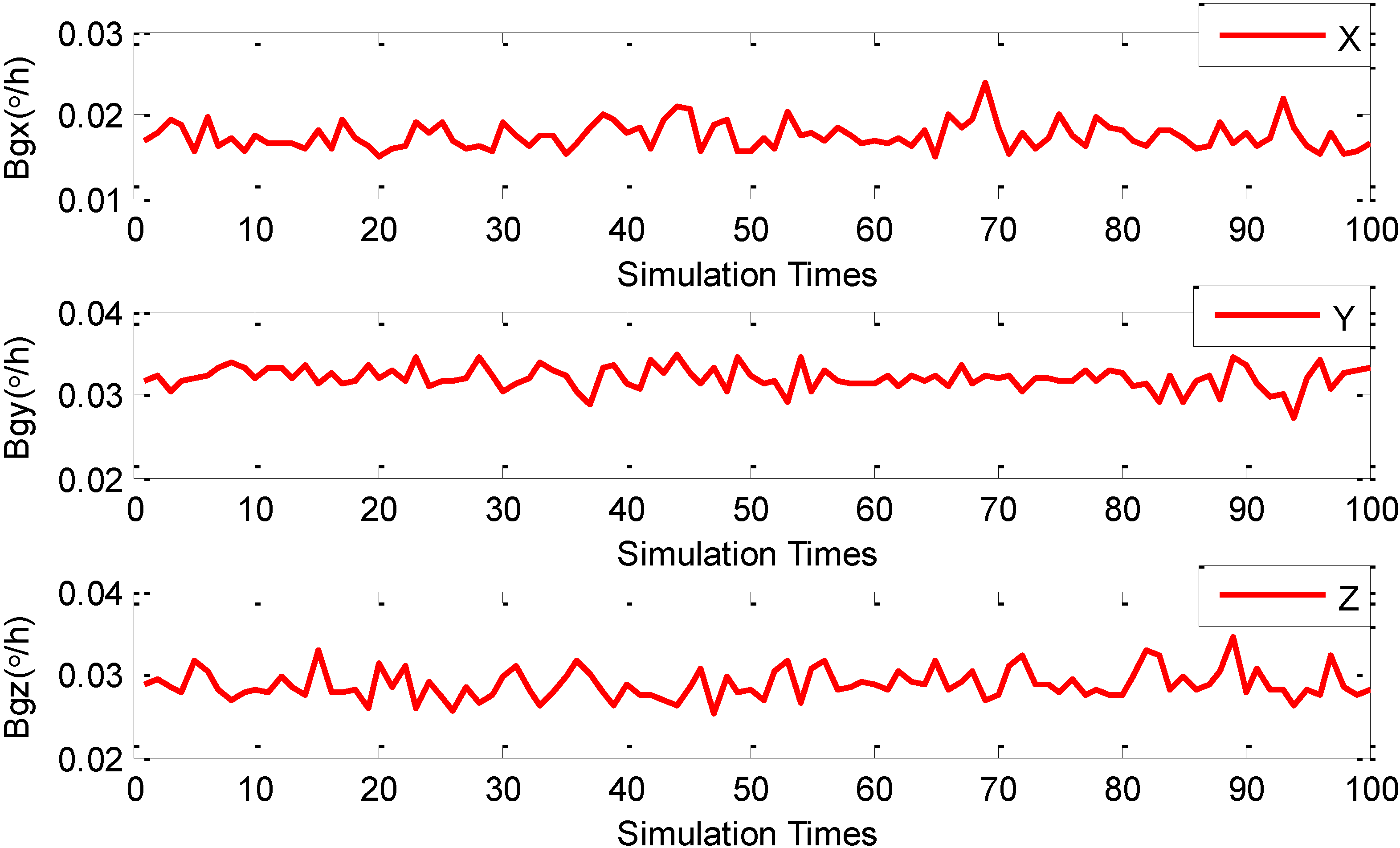
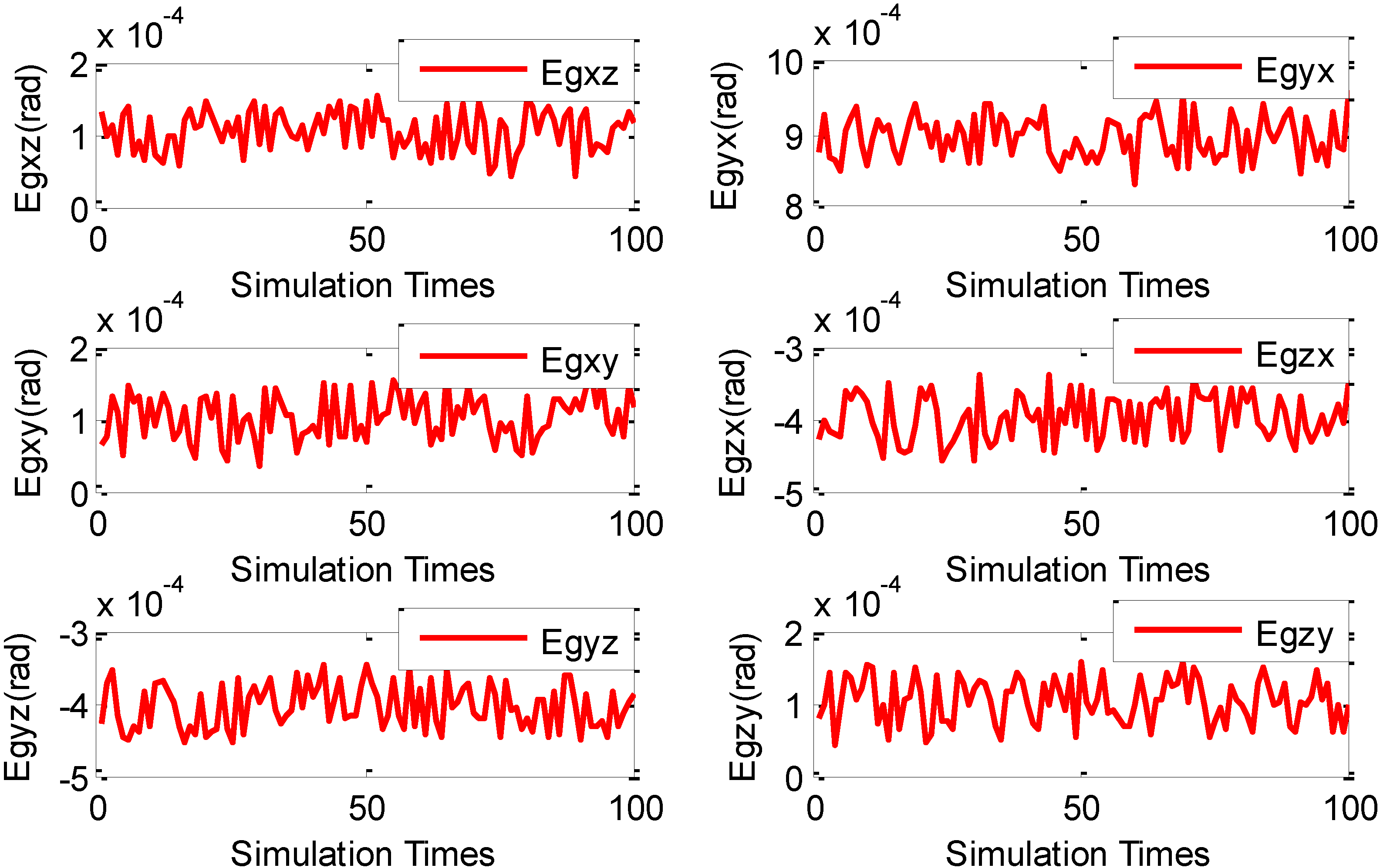
| Parameters | Preset Value | MCS-NAFSA Identification Result | Relative Error | Standard Deviation |
|---|---|---|---|---|
| (bit·h/°) | 643.50373651 | 643.50374138 | 0.00912194 | 0.01464 |
| (bit·h/°) | 645.62852456 | 645.62855074 | 0.04054963 | 0.01458 |
| (bit·h/°) | 645.17583651 | 645.17586147 | 0.03868713 | 0.01422 |
| (°) | 0.00099183 | 0.00099161 | 0.00021812 | 2.792 × 10−5 |
| (°) | 0.00010717 | 0.00010730 | 0.00121303 | 3.155 × 10−5 |
| (°) | −0.00037044 | −0.00037021 | 0.00062088 | 3.069 × 10−5 |
| (°) | 0.00014048 | 0.00014061 | 0.00092540 | 2.924 × 10−5 |
| (°) | 0.00010505 | 0.00010533 | 0.00247501 | 3.026 × 10−5 |
| (°) | −0.00041586 | −0.00041614 | 0.00067330 | 3.176 × 10−5 |
| (°/ h) | 0.01562779 | 0.01565329 | 0.001633171 | 0.001632 |
| (°/ h) | 0.03213767 | 0.03217083 | 0.001031810 | 0.001369 |
| (°/ h) | 0.02793626 | 0.02790215 | 0.001222490 | 0.001780 |

5. Experiments and Discussion
| Parameter Items | Performance Indicators |
|---|---|
| FOG dynamic range (°/s) | −800–+800 |
| FOG scale factor stability (ppm) | 10 |
| FOG bias instability (°/h) | 0.005 |
| FOG angular random walk (°/h1/2) | 0.0005 |
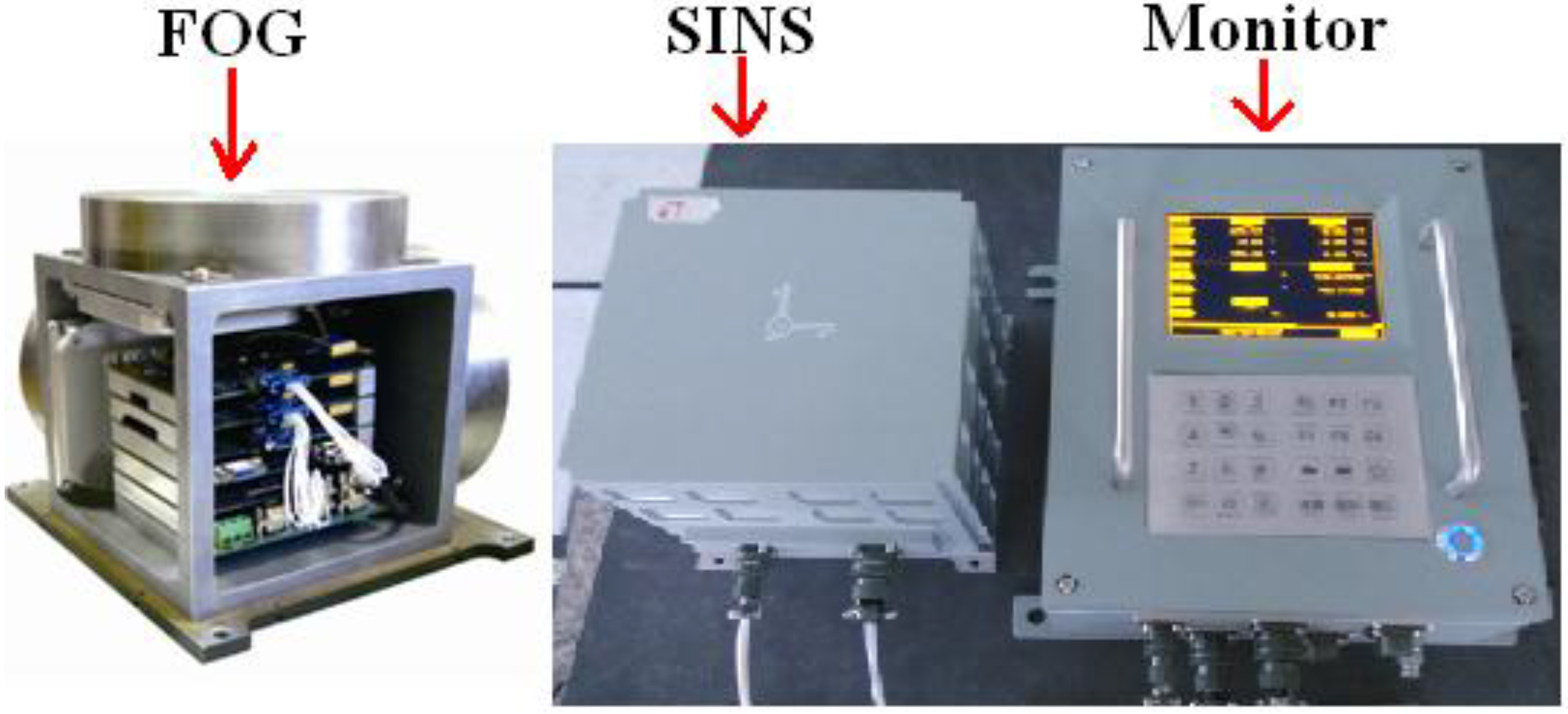
6. Conclusions
Acknowledgments
Author Contributions
Conflicts of Interest
References
- Li, X.; Shao, Z.; Qian, J. An optimizing method based on autonomous animate: Fish swarm algorithm. Syst. Eng. Theory Pract. 2002, 11, 32–38. [Google Scholar]
- Mehdi, N.; Ghodrat, S.; Mehdi, S.; Adel, N.T. Artificial fish swarm algorithm a survey of the state-of-the-art, hybridization, combinatorial and indicative applications. Artif. Intell. Rev. 2014, 42, 965–997. [Google Scholar] [CrossRef]
- Fran, S.L.; Valder, S., Jr. Fish Swarm Optimization Algorithm Applied to Engineering system design. Lat. Am. J. Solids Struct. 2014, 11, 143–156. [Google Scholar] [CrossRef]
- Li, X.; Xue, Y.; Lu, F. Applications of artificial fish school algorithm in combinatorial optimization problems. J. Shandong Univ. (Eng. Sci.) 2004, 34, 64–67. [Google Scholar]
- Milan, T.; Nebojsa, B.; Nadezda, S. Multithreaded implementation and performance of a modified artificial fish swarm algorithm for unconstrained optimization. Int. J. Math. Comput. Simul. 2013, 7, 215–222. [Google Scholar]
- Shen, W.; Guo, X.; Wu, C. Forecasting stock indices using radial basis function neural network optimized by artificial fish swarm algorithm. Knowl. Based Syst. 2011, 24, 378–385. [Google Scholar] [CrossRef]
- Song, R.; Chen, X.; Shen, C.; Hong, Z. Modeling FOG Drift Using Back-Propagation Neural Network Optimized by Artificial Fish Swarm Algorithm. J. Sens. 2014, 2014, 1–6. [Google Scholar] [CrossRef]
- Vannoorenberghe, P.; Flouzat, G. A belief-based pixel labeling strategy for medical and satellite image segmentation. In Proceedings of the IEEE International Conference on Fuzzy Systems, Vancouver, BC, Canada, 16–21 July 2006; pp. 1093–1098.
- Wong, A.; Li, G. Simultaneous pattern and data clustering for pattern cluster analysis. IEEE Trans. Knowl. Data Eng. 2008, 20, 911–923. [Google Scholar] [CrossRef]
- Fei, T.; Zhang, L.; Li, Y.; Yang, Y.; Wang, F. The artificial fish algorithm to solve traveling salesman problem. In Proceeding of the International Conference on Computer Science and Information Technology, Chennai, India, 27–28 December 2014; pp. 679–685.
- Jiang, M.; Zhu, K. Multiobjective Optimization by Artificial Fish Swarm Algorithm. In Proceedings of the International Conference on Computer Science and Automation Engineering (CSAE), Shanghai, China, 10–12 June 2011; pp. 506–511.
- Cheng, Z.; Hong, X. PID controller parameters optimization based on artificial fish swarm algorithm. In Proceedings of the IEEE Fifth International Conference on Intelligent Computation Technology and Automation (ICTA), Zhangjiajie, China, 12–14 January 2012; pp. 265–268.
- Tsai, H.; Lin, Y. Modification of the fish swarm algorithm with particle swarm optimization formulation and communication behavior. Appl. Soft Comput. 2011, 11, 5367–5374. [Google Scholar] [CrossRef]
- Chih, M. Self-adaptive check and repair operator-based particle swarm optimization for the multidimensional knapsack problem. Appl. Soft Comput. 2015, 26, 378–389. [Google Scholar] [CrossRef]
- Chih, M.; Lin, C.J.; Chern, M.S.; Ou, T.Y. Particle Swarm Optimization with Time-Varying Acceleration Coefficients for the Multidimensional Knapsack Problem. Appl. Math. Model. 2014, 38, 1338–1350. [Google Scholar] [CrossRef]
- Chih, M.; Yeh, L.L.; Li, F.C. Particle Swarm Optimization for the Economic and Economic Statistical Designs of the X Control Chart. Appl. Soft Comput. 2011, 11, 5053–5067. [Google Scholar] [CrossRef]
- Chih, M.; Lin, Y.C.; Chung, Y.Y. A Particle Swarm Optimization Approach Based on Monte Carlo Simulation for Solving the Complex Network Reliability Problem. IEEE Trans. Reliab. 2010, 59, 212–221. [Google Scholar] [CrossRef]
- Wang, L.; Shi, Q. Parameters analysis of artificial fish swarm algorithm. Comput. Eng. 2010, 36, 169–171. [Google Scholar]
- Yazdani, D.; Saman, B.; Sepas-Moghaddam, A.; Mohammad-Kazemi, F.; Meybodi, M.R. A new Algorithm Based on Improved Artificial Fish Swarm Algorithm for Data Clustering. Int. J. Artif. Intell. 2013, 11, 1–29. [Google Scholar]
- Lefevre, H.C. The fiber-optic gyroscope: Actually better than the ring-laser gyroscope? In Proceedings of the OFS2012 22nd International Conference on Optical Fiber Sensors, Beijing, China, 15–19 October 2012.
- Pavlath, G.A. Fiber Optic Gyros Past, Present, and Future. In Proceedings of the OFS2012 22nd International Conference on Optical Fiber Sensors, Beijing, China, 15–19 October 2012; pp. 842102-1–842102-10.
- Titterton, D.H.; Weston, J.L. Strapdown Inertial Navigation Technology, 2nd ed.; Co-published by the American Institute of Aeronautics and Astronautics and the Institution of Electrical Engineers: London, UK, 2004; Volume 71–73, pp. 342–361. [Google Scholar]
- Li, Q.; Ben, Y.; Sun, F. A novel algorithm for marine strapdown gyrocompass based on digital filter. Measurement 2013, 46, 563–571. [Google Scholar] [CrossRef]
- Aboelmagd, N.; Tashfeen, B.; Karamat, J.G. Fundamentals of Inertial Navigation, Satellite-Based Positioning and their Integration; Springer: Heidelberg, Germany, 2013; pp. 167–199. [Google Scholar]
- Yang, X.; Meng, H.; Wang, S. Calibration method for laser gyro SINS under outer field dynamic conditions. J. Chin. Inert. Technol. 2011, 19, 393–398. [Google Scholar]
- Deming, H.; Lu, C. Inertial Navigation Systems; Harbin Engineering University Press: Harbin, China, 1999; pp. 77–78. [Google Scholar]
- Wang, T.; Gao, Y.; Li, G.; Lin, Q. FOG random drift modeling by artificial fish swarm algorithm. J. Chin. Inert. Technol. 2012, 20, 358–362. (In Chinese) [Google Scholar]
- Yu, X.; Xu, Y.; Wei, G.; Long, X. Temperature compensation method for bias of ring laser gyroscope based on artificial fish swarm algorithm. Infrared Laser Eng. 2014, 43, 81–87. (In Chinese) [Google Scholar]
- Gao, Y.; Guan, L.; Wang, T.; Cong, X. Research on the Calibration of FOG Based on AFSA. In Proceedings of the 2013 IEEE International Conference on Machatronics and Automation, Takamatsu, Japan, 4–7 August 2013; pp. 412–417.
- Gao, Y.; Guan, L.; Wang, T. Optimal artificial fish swarm algorithm for the field calibration on marine navigation. Measurement 2014, 50, 297–304. [Google Scholar] [CrossRef]
- Yang, Q.; Chen, Y. Monte Carlo methods for reliability evaluation of linear sensor systems. IEEE Trans. Reliab. 2011, 60, 305–314. [Google Scholar] [CrossRef]
- Shi, Y.; Eberhart, R. A Modified Particle Swarm Optimizer, Evolutionary Computation. In Proceedings of the IEEE International Conference on World Congress on Computational Intelligence, Anchorage, AK, USA, 4–9 May 1998; pp. 69–73.
- Jiao, F.; Li, J.; Chu, Z. An improved six-position hybrid Calibration for RLG POS in full temperature. In Proceedings of the 8th IEEE International Symposium on Instrumentation and Control Technology, London, UK, 11–13 July 2012; pp. 246–250.
- Sun, F.; Lan, H.; Xia, J. Research on calibration of IFOG based on angle increment experiment. In Proceedings of the IEEE International Conference on Machatronics and Automation, London, UK, 11–13 July 2012; pp. 1761–1772.
- Wang, Q.Y.; Zhao, Q.; Sun, F. Six-position calibration for the fiber optic gyro based on a double calculation program. Opt. Eng. 2013, 52. [Google Scholar] [CrossRef]
- Fu, L.; Zhu, Y.Q.; Wang, L.; Wang, X. A D-optimal Multi-position Calibration Method for Dynamically Tuned Gyroscopes. Chin. J. Aeronaut. 2011, 24, 210–218. [Google Scholar] [CrossRef]
- Cai, Q.; Song, N.; Yang, G.; Liu, Y. Accelerometer calibration with nonlinear scale factor based on multi-position observation. Measur. Sci. Technol. 2013, 24, 1–9. [Google Scholar]
- Song, W.T.; Schmeiser, B.W. Omitting meaningless digits in point estimates: The probability guarantee of leading-digit rules. Oper. Res. 2009, 57, 109–111. [Google Scholar] [CrossRef]
- Law, A.M. Simulation Modeling and Analysis, 4th ed.; mcGraw-Hill: Boston, MA, USA, 2007. [Google Scholar]
- Savage, P.G. Strapdown Inertial navigation System Algorithm design, Part 2: Velocity and Position Algorithms. AIAA J. Guid. Control Dyn. 1998, 21, 208–221. [Google Scholar] [CrossRef]
- Salychev, O.S. Applied Inertial Navigation: Problems and Solutions; BMSTU Press: Moscow, Russia, 2004. [Google Scholar]
© 2015 by the authors; licensee MDPI, Basel, Switzerland. This article is an open access article distributed under the terms and conditions of the Creative Commons Attribution license (http://creativecommons.org/licenses/by/4.0/).
Share and Cite
Gao, Y.; Guan, L.; Wang, T.; Sun, Y. A Novel Artificial Fish Swarm Algorithm for Recalibration of Fiber Optic Gyroscope Error Parameters. Sensors 2015, 15, 10547-10568. https://doi.org/10.3390/s150510547
Gao Y, Guan L, Wang T, Sun Y. A Novel Artificial Fish Swarm Algorithm for Recalibration of Fiber Optic Gyroscope Error Parameters. Sensors. 2015; 15(5):10547-10568. https://doi.org/10.3390/s150510547
Chicago/Turabian StyleGao, Yanbin, Lianwu Guan, Tingjun Wang, and Yunlong Sun. 2015. "A Novel Artificial Fish Swarm Algorithm for Recalibration of Fiber Optic Gyroscope Error Parameters" Sensors 15, no. 5: 10547-10568. https://doi.org/10.3390/s150510547






